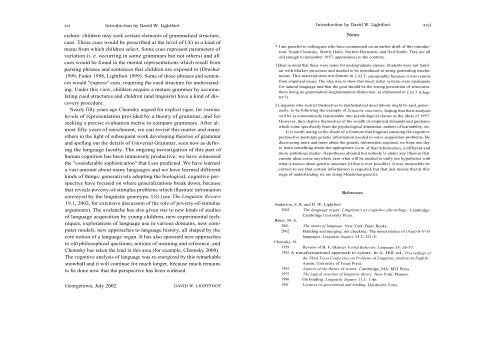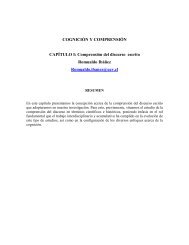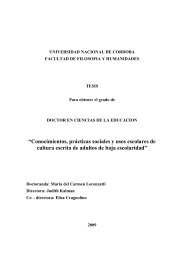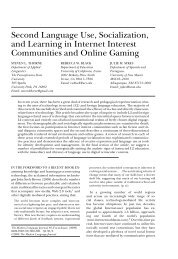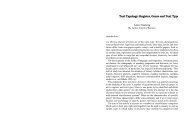Syntactic Structures
Syntactic Structures
Syntactic Structures
You also want an ePaper? Increase the reach of your titles
YUMPU automatically turns print PDFs into web optimized ePapers that Google loves.
xvi Introduction by David W. Lightfoot Introduction by David W. Lightfoot xvii<br />
cedure: children may seek certain elements of grammatical structure,<br />
cues. These cues would be prescribed at the level of UG in a kind of<br />
menu from which children select. Some cues represent parameters of<br />
variation (i. e. occurring in some grammars but not others) and all<br />
cues would be found in the mental representations which result from<br />
parsing phrases and sentences that children are exposed to (Dresher<br />
1999, Fodor 1998, Lightfoot 1999). Some of those phrases and sentences<br />
would "express" cues, requiring the cued structure for understanding.<br />
Under this view, children acquire a mature grammar by accumulating<br />
cued structures and children (and linguists) have a kind of discovery<br />
procedure.<br />
Nearly fifty years ago Chomsky argued for explicit rigor, for various<br />
levels of representation provided by a theory of grammar, and for<br />
seeking a precise evaluation metric to compare grammars. After almost<br />
fifty years of enrichment, we can revisit this matter and many<br />
others in the light of subsequent work developing theories of grammar<br />
and spelling out the details of Universal Grammar, seen now as defining<br />
the language faculty. The ongoing investigation of this part of<br />
human cognition has been immensely productive; we have witnessed<br />
the "considerable sophistication" that Lees predicted. We have learned<br />
a vast amount about many languages and we have learned different<br />
kinds of things: generativists adopting the biological, cognitive perspective<br />
have focused on where generalizations break down, because<br />
that reveals poverty-of-stimulus problems which illustrate information<br />
conveyed by the linguistic genotype, UG (see The Linguistic Review<br />
19.1, 2002, for extensive discussion of the role of poverty-of-stimulus<br />
arguments). The avalanche has also given rise to new kinds of studies<br />
of language acquisition by young children, new experimental techniques,<br />
explorations of language use in various domains, new computer<br />
models, new approaches to language history, all shaped by the<br />
core notion of a language organ. It has also spawned new approaches<br />
to old philosophical questions, notions of meaning and reference, and<br />
Chomsky has taken the lead in this area (for example, Chomsky 2000).<br />
The cognitive analysis of language was re-energized by this remarkable<br />
snowball and it will continue for much longer, because much remains<br />
to be done now that the perspective has been widened.<br />
Georgetown, July 2002 DAVID W. LIGHTFOOT<br />
Notes<br />
* I am grateful to colleagues who have commented on an earlier draft of this introduction:<br />
Noam Chomsky, Morris Halle, Norbert Hornstein, and Neil Smith. They are all<br />
old enough to remember 1957, appearances to the contrary.<br />
I Bear in mind that these were notes for undergraduate classes. Students were not familiar<br />
with Markov processes and needed to be introduced to string generating mechanisms.<br />
This material does not feature in LSLT, presumably because it was remote<br />
from empirical issues. The idea was to show that much richer systems were inadequate<br />
for natural language and that the goal should be the strong generation of structures,<br />
there being no grammatical-ungrammatical distinction, as elaborated in LSLT (Chapter<br />
5).<br />
2 Linguists who restrict themselves to mathematical descriptions might be said, generously,<br />
to be following the example of <strong>Syntactic</strong> structures, hoping that their analyses<br />
will be as automatically translatable into psychological claims as the ideas of 1957.<br />
However, they deprive themselves of the wealth of empirical demands and guidance<br />
which come specifically from the psychological dimension, matters of learnability, etc.<br />
It is worth noting in the shade of a footnote that linguists pursuing the cognitive<br />
perspective postulate genetic information needed to solve acquisition problems. By<br />
discovering more and more about the genetic information required, we hope one day<br />
to learn something about the appropriate form of that information, a different and<br />
more ambitious matter. Hypotheses abound but nobody is under any illusion that<br />
current ideas come anywhere near what will be needed to unify our hypotheses with<br />
what is known about genetic structure (if that is ever possible). It may meanwhile be<br />
correct to say that certain information is required, but that just means that at this<br />
stage of understanding we are doing Mendelian genetics.<br />
References<br />
Anderson, S. R. and D. W. Lightfoot<br />
2002 The language organ: Linguistics as cognitive physiology. Cambridge:<br />
Cambridge University Press.<br />
Baker, M. A.<br />
2001 The atoms of language. New York: Basic Books.<br />
2002 Building and merging, not checking: The nonexistence of (Aux)-S-V-O<br />
languages. Linguistic Inquiry 33.2: 321-8.<br />
Chomsky, N.<br />
1959 Review of B. F. Skinner Verbal Behavior. Language 35: 26-57.<br />
1962 A transformational approach to syntax. In A. Hill, ed., Proceedings of<br />
the Third Texas Conference on Problems of Linguistic Analysis in English.<br />
Austin: University of Texas Press.<br />
1965 Aspects of the theory of syntax. Cambridge, MA: MIT Press.<br />
1975 The logical structure of linguistic theory. New York: Plenum.<br />
1980 On binding. Linguistic Inquiry 11.1: 1-46.<br />
1981 Lectures on government and binding. Dordrecht: Foris.


